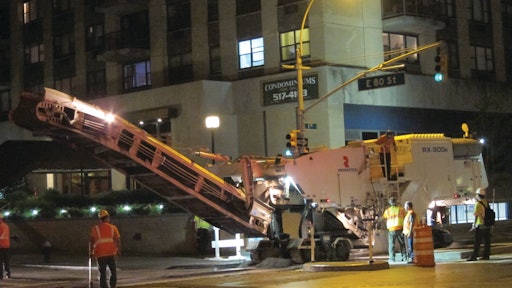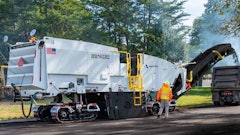
First Avenue in New York City has to rank as one of the busiest city streets in the world. It is a concrete roadway that spans five lanes wide; traffic runs one way to the north. The avenue carries passenger vehicles, taxis, buses and trucks that total into the thousands every day. Over the years, First Avenue in the city’s Upper East Side had become polished, cracked, spalled, faulted and patched with asphalt in various locations.
So the city decided to rehabilitate 52 blocks of the roadway, in a combined effort between the Department of Design and Construction (DDC) and the Department of Transportation (DOT). The most cost-effective solution, the city determined, was to mill down the concrete to level it out and overlay the surface with a special polymerized asphalt (see box).
Challenges of milling concrete
Milling concrete is not uncommon, but it’s also not easy. When done with a regular asphalt milling drum, the milling machine slows to a crawl. Production is difficult and tedious.
To increase milling production and produce a finely-textured surface on the concrete, the city’s contractor, Carlo Lizza & Sons Paving Inc., elected to micromill the concrete with a Roadtec RX-900e milling machine fitted with a special 400-tooth Road Runner Fine Milling Head. By contrast, a regular asphalt milling drum has just 180 teeth, says Jeff Rule Sr., cutter drum manager for Roadtec.
Working at night, the milling machine could mill along, going about an inch deep, at 35 to 40 feet per minute, says Rule. “With this style of drum we could increase the ground speed, and increase their tooth life,” says Rule. “We were there for two nights, and in two nights they only changed maybe a dozen teeth. And the surface they got was beautiful. It was finely textured, and enabled them to get a good bond with the asphalt overlay.”
Tim Penza, project coordinator for Carlo Lizza & Sons, explains it this way: “The special drum gave us the ability to profile the concrete. We cut 8 feet wide with one pass. We went from a quarter inch deep at the crown to 1.5 inches at the curb. We cut 70 feet wide by 52 blocks, which is about 14 lane miles. The project stretched from 72nd Street to 125th Street on First Avenue.
“We micromilled, then we blew out and sealed the cracks with patching material,” continues Penza. “Then we put down 100 percent liquid asphalt tack coat and then a fiberglass fabric. The DOT paved the overlay on top of the fiberglass fabric; the overlay was 1.5 to 2 inches thick.”
Creating a finer finish
Aly Lizza Jr., head of Lizza’s New York City Division, says: “Micromilling gives you a much finer finish. The finish is very fine and evenly grooved. It produces a completely different finish than you get by milling asphalt with a regular asphalt drum.”
The contractor closed half of First Avenue at a time, for a nightly working distance. “Our traffic patterns varied, depending on the arterial streets coming into First Avenue,” says Penza. “We had to square up every night, so we did some sections from curb to curb every night.”
Aly Lizza Jr. says he appreciates the job the milling machine did. “We really used the hell out of that drum on the concrete," he said. "It held up great though. Everything was new on this project. Milling concrete was new, the fabric was new, and the asphalt mix was new.”
Meanwhile, a Roadtec RX-100e utility milling machine was used to mill around manhole covers and other obstructions.
Eric Brown, Deputy Director of Roadway Paving for the Manhattan Division, New York City DOT, said the city offset the joints in the asphalt from the original joints in the concrete. So if the concrete panels were on 12-foot centers, the DOT set the asphalt paver at 14 feet wide. That measure helps prevent reflective cracking.
Brown said the micromilling enabled the asphalt overlay “to get a better bite on the surface of the concrete. It helped us create a better bond.”
For Carlo Lizza & Sons Paving, Hicksville, N.Y., John Keeling was the project superintendent.


















![Screen Shot 2023 01 04 At 5 23 30 Pm[35]](https://img.forconstructionpros.com/files/base/acbm/fcp/image/2023/01/Screen_Shot_2023_01_04_at_5.23.30_PM_35_.63bc42696de27.png?auto=format%2Ccompress&fit=crop&h=135&q=70&w=240)


![Bm 2200 65 Cold Planer Release[17]](https://img.forconstructionpros.com/files/base/acbm/fcp/image/2023/06/BM_2200_65_Cold_Planer_release_17_.649359d81b660.png?auto=format%2Ccompress&fit=crop&h=135&q=70&w=240)





